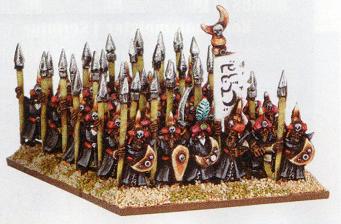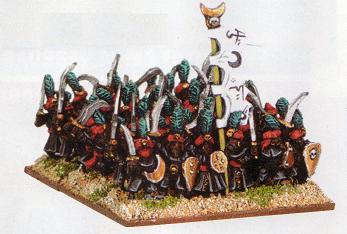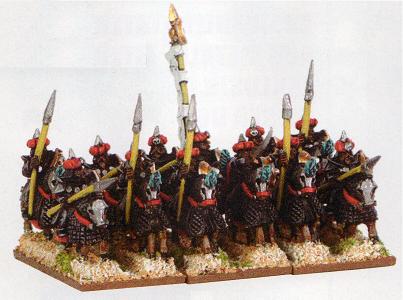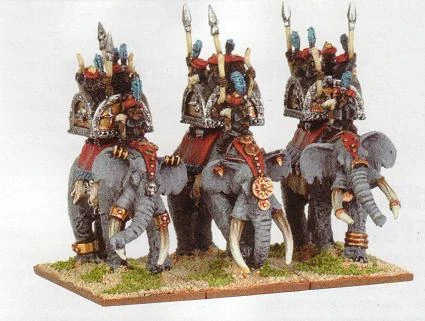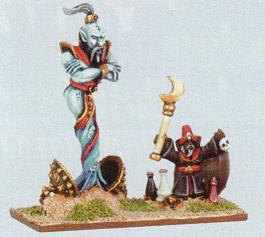Map of Araby.
An ancient realm of Men, Araby is a strange and exotic country, ruled by powerful sultans and desert sheiks.[21a] Araby is located south of the Old World, west of Nehekhara and northwest of the Southlands' rainforests.[4c][11a] It rises across vast expanses of desert, and we find its cities on the Coast of Araby, to the west, to the northern borders of the Southlands.[13]
Overview
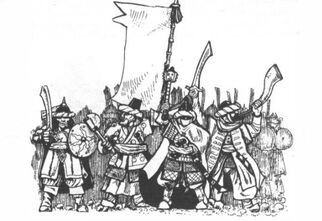
A group of Arabyan warriors.[18]
Little is known about Araby compared to the Old World. Its merchants travel and trade extensively throughout the world, establishing trade networks that span every sea and nation.[11a] Their society is notoriously focused on commerce and piracy, both of which, carried out on a global scale, bring them fabulous wealth: their sultans and caliphs are said to be richer than the Dwarves. This trade is carried beyond the sea thanks to its dhows, fast ships with triangular sails. They have a remarkable interest in science, medicine, and magical knowledge, and their nobles invest large sums to fund research of all kinds.[11a]
On many occasions, the Arabyans have tried to establish themselves outside their homes, occupying territories such as Sartosa[3b] or the Border Princes.[27] Such would be the case of Luyt'ama Rah'slyn, Fatandira or Abdul Al'Shar. In addition, it maintains colonies in many distant cities, such as in distant Marienburg, where a prosperous and ancient Arabyan community, known as Arabierstad, has formed.[12b]
Arabyan cities are exotic and extravagant, where massive vaulted palaces, filled with wealth beyond the imaginations of the dwarfs, loom over adobe and stucco houses in winding streets.[28] Its lively and bustling nights, street performers, music, alcohol, narcotics, fiery food, and concubines make Araby a charming and irresistible place for many travelers. The Arabyans are colorful people, who live every moment with passion, because vitality runs wild through their veins, as hot as the sun itself. Most of the arabyans are an impious people, who do not feel much devotion to the gods, especially among their leaders.[19a] Although the common people of Araby worship the powerful Djinns with offerings and idols.[11a] It is said that Arabyans can be greedy and cruel, but they are always involved in some exotic adventure.[29a]
The toughest warriors come from the nomadic desert tribes, who are highly feared by the more civilized merchants who roam the caravan routes through the vast deserts.[11a] The most notable warriors of Araby are the Dervishes, warriors and religious fanatics all too willing to die for their faith. Other very famous are the Eunuch Warriors, individuals trained from birth to serve as soldiers or guards.[17b] The Arabyans know firearms, having developed the first jezzails themselves. Mostly, these weapons end up mounted on camels, to be used in fleeting skirmishes.[30e] In addition, Arabyans engineers developed the first flintlocks weapons, these being much more advanced than the wheellocks weapons, used in the Empire at that time.[30d]
In the bazaars and markets of Araby, crowds often gather around a seated Arabyan mystic playing a flute. Hypnotizing through music, though some say using his rhythmic swaying, a deadly poisonous snake. Snake Charmers generally survive on the money they earn as artists, but often some offer their services, and that of their snakes, as warriors.[31c] Likewise, Southlanders from the jungles come to Araby to serve as warriors and mercenaries, as well as many other races, such as Ogres.[11a]
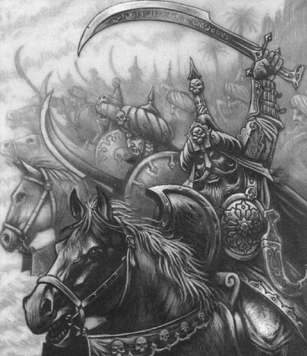
The Sultan of All Araby claims to rule the whole peninsula, but has little real power over the independent coastal city-states or over the fierce nomad tribes who wander the Great Desert of Araby. The power wielded by the Great Sultan, now Padishah the Great, from Al-Haikk, the capital of all Araby, is supported by the fickle loyalty of the nobles. The Arabyans Princes and Emirs, the noble class among the Arabyans, tend to be very independent, as well as the rest of the Sultans, ruling their cities with impunity.[11a] [18a] Even the Sheiks and Emirs of the land are constantly warring with each other.[23a] The fierce Sheikhs of the desert are local leaders, being renowned warriors and military men. In most cases they are the Viziers, personal advisers of the Sultans, those in charge of commanding the armies on the battlefield, with the notable exception of the Great Sultan. This is so because the Sultans of Copher, Lashiek, Martek, Ka-Sabar, Aiir, and El-Kalabad live in unimaginable luxury. They are served by hundreds of slaves who will fulfill all their whims, their harems are full of voluptuous beauties from all over the world and their treasure chambers with all the splendor and wealth of this distant land. That is why they are reluctant to step on the battlefield, preferring to delegate their viziers to command their armies.[11a] [18a] Arabyans women have the same inheritance rights as men, and can rule cities as princess, or even become Sultans.[28] Among nomadic tribes there is also this norm, since they have no major problem being led by a woman, both in government and on the battlefield.[27]
Crowds of nomads and adventurers from Araby venture into the Lands of the Dead to loot the tombs and obtain their treasures. Such as the famous treasure hunter Ibn Sullan, they long for the wealth forgotten in time, risking their lives among the sarcophagi. Occasionally, a young Sheikh, eager to prove his worth and that of his people, will venture into the Land of the Dead to claim treasures for himself and discover unknown riches.[31d][32a] Frequently, the leaders of Araby send their forces towards the pyramids of Nehekhara, with the mission of looting the tombs and burning the evil and ancient scrolls they find, thus preventing the dead from rising again. Sultans often hire mercenaries for these types of missions. They return to Tilea covered in wealth and valuable relics, though many fail to escape the wrath of the desert.[3e]
Piracy is a fundamental pillar in Araby, sustaining many of its commercial activities.[11a] The corsairs are in charge of ending the rival fleets, thus monopolizing the trade routes.[14a] Furthermore, the corsairs are mostly slave owners, bringing new shipments of slaves to the markets of Araby, enriching themselves enormously in the process. These corsairs orbit mostly around the city of Lashiek, being their base of operations, and the city where they can sell their loot of slaves.[11a] If Arabyans corsairs are renowned for something, it is for their discipline. They are cruel warriors, experts in navigation, who do not allow themselves to be intimidated in any sea.[3b] The most important of them all is the Sultan of the Seas, Golden Magus.[33a]
Magic
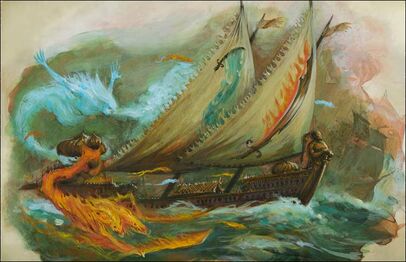
Flaming Scimitar surrounded by Djinns
Araby lies far from the world's poles and therefore from the ultimate source of the magical winds that blow from the north. As a result magic that is common in the Old World is far more diffuse in Araby so it is much more difficult for sorcerers to work their spellcraft. Arabyan magic has therefore developed quite differently than that of other men. Arabyan sorcerers use their powers to control elemental Spirits of the Desert, Djinns, Efreets, Genies and such-like spirits. These spirits are worshipped by the superstitious and the common people of Araby. These so-called elemental creatures are all daemons of a kind, but so far removed and isolated from the source of magical power in the north that they rely upon the close presence of powerful magical artefacts to maintain their existence. They also sometimes cling to local áreas where a vestige source of magical energy may be found, but in such cases their power is not usually great. Much Arabyan magic is based upon creating and using forms of magical containment such as cages, boxes, or crystals, which are used to capture and enslave these Daemons.[11a]
In Araby, the Djinns are used as a source of magic, since the Winds of Magic are extremely weak in this region. The wizards of Araby have created gadgets to help them control these Winds of Magic. Strange flasks are used to lock the Djinns inside, and to extract their magical power.[11a] Another of these artifacts would be the Arabyan Puzzlebox, an elegant mechanism that allows its wearer to take advantage of the Winds of Magic correctly, using the sparkling gems that it houses inside.[34a] The power of the spirits has served to create a Lore of Magic typical of Araby, known as Lore of the Djinns. Its spells contain unparalleled power, channeling the magical energies of these divine spirits.[11c][32d]
Mystery shrouds the study of Necromancy. To learn the Dark Art, an aspirant must either seek a Necromancer and become an apprentice or acquire one of the Forbidden Tomes such as the Book of the Dead, written by the mad Arabyan prince Abdul ben Raschid. He travelled to the Land of the Dead in the east of Araby, and driven mad by his experiences, he wrote his blasphemous masterpiece. He did not live to see the widespread public revulsion of his work, or the great pyre where the Caliph of Ka-Sabar burned all the copies he could find. Unfortunately, the Caliph did not find them all.[35a] In Araby, knowledge of necromancy is not suppressed, and so they do not suffer from the ignorance that allows Vampires to gain footholds amongst them as in the Empire. Only the Blood Dragons have a presence there, and that is in the western desert.[36a] Works such as the Cursed Book, by the Arabyan necromancer Har-Ak-Iman, remain a remnant of this dark art among the dunes.[37a]
Magic items are common in Araby, used by its sorcerers and mystics. Among them are the renowned magic rugs, used as saddles by many renowned Arabyans. Other artifacts could be the Enchanted Ropes, living objects, that will help their master in battle. Being a society closely tied to magic, powerful relics and magical items are common among the people of Araby.[4b] Another example would be the Cobra Belt, a magical artifact that transforms into a poisonous snake at the command of its master.[38a] Ibn Naggazar was one of these renowned sorcerers, who in his brilliance, and also in his madness, wrote the Black Book of Ibn Naggazar. A tome where he compiled formulas to create intoxicating elixirs, influenced by the whispers of demons.[34a] Others speak of Kaphamon, an Arabyan magician skilled in the Lore of Death, who created a multitude of magical artifacts of incredible power, such as the Staff of Kaphamon.[36c]
In Araby there is the stain of Chaos, in the form of the Cult of Mirrors, worshipers of Tzeentch, among others.[39a] Also, Beastmen roam this land. In Araby, unlike the Old World, Horned Ones do not have the appearance of bovids, but are described as Apemen. They are extremely intelligent, able to organize themselves and use weapons and tools in the cunning attacks they carry out against the other inhabitants of the jungle.[40a]
Geography
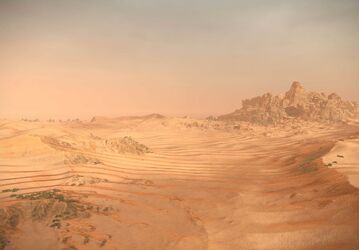
The land of Araby lies along the north west coast of the Southlands between the Atalan Mountains and the Great Ocean. To the east is the Great Desert of Araby that separates Araby from the Lands of the Dead.[11a] Araby is a hot, dry place, where water is scarce and few areas are really fertile. Much of the land is desert or shrub land, requiring careful irrigation to produce crops.[4b] Although the climate is dry and hot the western winds carry moisture laden clouds that give up their water as they are suddenly forced upwards by tall Atalan peaks. The resultant rain falls upon the mountains and gives rise to numerous seasonal streams that, in winter at least, form substantial westward flowing rivers. Although much of the land is dry the rivers bring the water needed by cities, towns and villages, there are also numerous oasis even in the arid regions to the south.[11a]
Geographically, Araby is divided between the territories of the Coast of Araby, northwest of the Atalan Mountains, and the Great Desert of Araby, known to the Arabyans as the Sahra Desert, where some important cities still lie. The domains of the Great Sultan extend to the border of the Southlands, where Ka-Sabar stands as the last Arabyan stronghold on the way south. Vast expanses of desert, dotted with small oases, are the norm in this region of the world, where heat and aridity are untouched.[11a][13] Anyone who travels through the desert should know the Harmattan, a dangerous wind that attracts sand storms, being able to hide the sun for days, as well as bury the unwary under the dunes.[41a] The most important mountain range in Araby are the Atalan Mountains, impassable in almost all their extension, except for the Cobra Pass. Other small mountains stand alone, such as the Mountain of the Eunuch, the Mountain of the Vulture or the Mountain of the Specters. Only two known rivers run the length of Araby. The main one is the Serpent River, south of Lashiek, flowing into the Corsair Bay, next to the Shark Strait.[13] The Crimson River also runs through much of Araby.[42a]
To the south, a natural enclave vital to the economy is the Gulf of Medes, where El-Kalabad rises. It receives a good part of the commerce coming from the east, being therefore a place of constant commercial traffic. To the north of Araby is the Old World, and to the northwest Ulthuan, and that is why Araby maintains control over the trade routes of the far east. Ships from Cathay and Ind flock to their ports after a long voyage around the Southlands. Its strategic location helps them maintain hegemony over commerce, monopolizing entire routes.[11a][14a]
Culture and Society
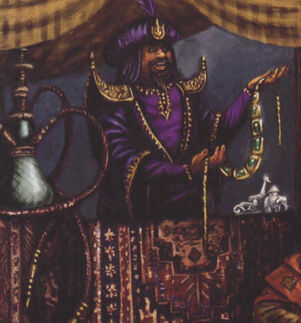
Arabyan Merchant
"The land of Araby it is called. A snow settles on the mountain here, so the sun settles on the great wastes of the Arabyans. Golden temples and ancient cities full of gems and jewels lie in the desert, or so it is said. The Arabyans are a fierce, independent people, with skins of tanned leather, long flowing robes and they ride upon strange horses with great humped backs that can walk for days without water. And as well they should, for the sun drinks all water except for a few pools and trickling rivers. It is death to travel the desert."
- —Tales of the Norsmen about the lands of Araby.[73a]
Most people think that the mysterious land of Araby is a barren land, ruled by savage heathens. And to an extent it is. It is well known that the populous is godless and bereft of faith. Their ways surely differ from the ones in the Old World, but there is much to admire. Arabyans are proud. They speak in loud, quick voices and vibrancy runs hot in their veins, heated by the burning sun. They are energetic people, overflowing with passion and indomitable spirit. Their coastal cities are centres of trade and commerce: long ships from the north pass sleek corsairs in the green deltas, Empire galleys skin the treacherous coastlines and tall Bretonnian sloops bring their wines to trade for silks and spices. No cities excite the imagination like those of Araby. Arabyans are not savages. They possess a proud civilisation, and have made great advances, especially in science, medicine and architecture. They champion the arts, It is only when one enters the southern portion of the land that civilisation ceases. The great sand desert, mountain ranges and valley passes are crawling with warring hill tribes and bandits. It is as if the land is divided in two. But for those who visit their cities, the colours, sounds, smells and people remain forever in their minds and their hearts.[19a]
Physically, Arabyans are described as short, dark, slender, with hooked noses and dark hair and eyes.[17b] Arabyan women are characterized by their curly hair, their full lips and their voluptuous curves. It is said of them that they have a very fierce, proud and passionate character.[28] Some of the cities of Araby are on the northern borders of the Southlands, and the people there are black skinned. But even with their remoteness, they share a common culture with the rest of the Arabyans. All Arabyans speak and understand Arabic, although most of the merchant classes would be able to handle Old Worlder fairly easily.[17b]
The Arabyans are a very jovial people, as they adore festivities and bustle. Narcotics and alcohol are not lacking in their celebrations, livening up spicy meats and other delicious foods. One of the most famous beverages in Araby is Tialva, which is similar to beer, but made from sorghum instead of wheat. Another very common drink is Arag, made with anise, very powerful. Although, without a doubt, the most sought-after Arabyans drink is coffee, which is exported to all the ports of the world in huge quantities. Narcotics are consumed in shishas, being frequent in taverns and pleasure palaces.[28] The Arabyans have a custom to sit on low chairs and pillows, and chairs are really rare in Araby. Comfort is something that is essential for the people of the desert.[43a]
Justice is fierce in Araby. Some of its leaders fiercely punish those criminals they manage to capture. Mutilation is a very common penalty, which deters many from even attempting to steal. Slavery is another common penalty, thus avoiding physical punishment, serving as a slave for as long as his new master deems necessary. The desert sheiks are especially famous for the cruelty of their sentences, which is why many bandits prefer to die in battle before being captured by the terrible rulers of the dunes.[18a][21a][32]
Marriage unions among Arabyans are somewhat different from the Old World inhabitants. For the common people, a simple ceremony unites a man and a woman in marriage, swearing "by the spirits of the wind, of the earth and of the water, to unite us in marriage, according to our will, and to love each other forever." Among the nobles, marital relations are somewhat diverse, marked especially by polygamy. Like the common people, they maintains technically monogamous relationships, since the nobles can only marry once, also swearing "before the people of Araby, to rule and serve justly".[28] But that does not mean that noble men and women do not have relationships with other people, especially those who have a harem of their own.[11a] In Araby they have a more permissive sexuality, and they do not look down on same-sex relationships, or a liking for both sexes.[43][44]

The Arabyans are great sailors and have for many centuries fished the adjoining seas and traded south along the coast, northwards to the Old World, and westwards as far as Ulthuan. The High Elves do not permit Arabyan vessels to travel further west tan Ulthuan itself, their high-prowed dhows are a common sight in the outer harbours of Lothern. For their part the High Elves maintain a mercantile presence in Copher and Lashiek as they have since time immemorial. The Elves and men of Araby had dealings even during the long centuries when the Elves abandoned the Old World. Being not only capable seamen but also bold and adventurous, Arabyans will eagerly exchange fishing and trading for piracy, and nowhere is this more the case than in Lashiek which is consequently known as the City of Corsairs.[11a] The greatest slave markets are in Araby, and the lot of those sold there is a miserable one; in the Old World, some people are enslaved by the courts, for non-payment of debts or similar offences.[4a]
The Arabyans were able to establish and monopolise the trade routes into the lucrative jade and spice lands of the Far East such as Cathay and Ind, as well as trading with the barbaric Norse tribes establishing the largest slave market in the city of Lashiek, all this thanks to their unsurpassed mastery in their navigation of the seas. The economic growth of Araby has led their peoples to the pursue of the fine arts in poetry, alchemy, medicine and architecture thus producing some of the world's most notable poets, doctors, sorcerers and architects.[11a] Arabyan philosophers observe the night skies to discover the secrets of the world, a practice brought to the Empire by the Crusaders.[21b]
Araby coins named Rials[45], and we can find different types depending on the value. Gold pieces from bearing crossed scimitars, silver pieces showing rearing stallions, and bronze pennies displaying a crescent moon. They regularly appear in the Tilean city-states, Estalia, and the Border Princes.[30a]
Clothing
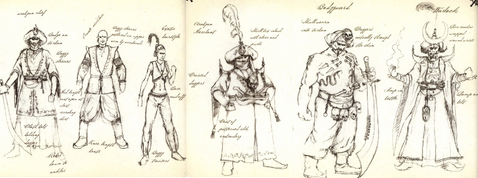
Inhabitants of Araby
The Arabyans dress mostly with elegant turbans, baggy sleeves gathered on upper arm by armbands, jewelry, ornaments and decorated pieces of silk. Many protect themselves with tough leather boots, crossed daggers, whose handles carry jewels and precious stones, and high shoulder pads.[19a] Araby merchants, on the other hand, wear long robes of dark cloth, elaborate turbans, and incorporate jewellery when they can.[30f] The Arabyan women have the tradition to wear exotic hairstyles, with headbands and ornaments of gold and silver, dress in baggy pants and wear their bellies exposed, wearing a bedlah.[19a] The Arabyans women often wear a bracelet or anklet, a piece of jewellery worn on the wrist or ankle. They can be solid metal or supple chains studded with gemstones. Bracelets are popular among the Tilean and Estalian ladies as a result of the Arabyan influence in these lands.[30h]
For the Arabyans, clothing is extremely important. Dressing properly, and also wearing certain trinkets and ornaments, is a sign of composure and decency. Those civilized peoples must dress as such, and breaching this rule is an insult to all their compatriots, for this reason the Arabyans take great care in taking care of their appearance and clothing.[43a]
Architecture
Arabyan buildings often have domed roofs and distinctive onion-shaped arches over doors. A single building is frequently constructed around a courtyard, which may contain a garden if the owner is wealthy; otherwise, it is a storage and work area. Most have only a single floor and are built of brick rather than stone. Decoration almost never includes recognisable figures but can be very elaborate. These swirling, abstract patterns often look like the work of Chaos to men of the Empire, though those who know about Chaos can tell that it is not; it is too orderly. This decoration may be painted, in which case it has faded badly, or a mosaic that may be dirty but can still be seen.[46a]
Arabyan single rooms are watchtowers or the strong rooms of the main building. Single buildings are normally the homes of the wealthy or small outposts for the military. Some are the keep of a small fortress, or a small part of a larger fortress. Fortresses and small houses are more common than temples or palaces, and are composed of a central keep surrounded by a wall, with outbuildings in the space between the keep and the wall. Villages consist of a number of courtyard homes, while towns and cities are larger versions of villages.[46a]
Although without a doubt, if a building stands out above the rest, it is the palaces. Sultans, princes and emirs live in immense palaces built of white stone, topped by gigantic golden vaults. Its size is absolutely colossal, with dozens of gardens and rooms inside. Its splendor rises above the rest of the buildings, reaffirming the power of those who inhabit them.[28]
Slavery
In Araby they are slavers by nature, forming an essential part of both their economy and their society. Slavery is an unparalleled source of wealth for the corsairs and noblemen of Araby, who fill their markets with slaves from all over the world. The city of Lashiek is famous for being the world capital of slavery, hosting the largest known market for buying and selling slaves. This has caused that the simple name of this city produces terror in the navigators and merchants that surround its waters. [11a][1a] Many slaves serve in the Palaces of Pleasure, a destiny shared by men and woman, or to be part of the harems of the Arabyan rulers.[7a] The Sheikhs, Emirs and Sultans of Araby live in unimaginable luxury, served by hundreds of slaves who fulfil their every whim.[18a] Palaces of Pleasure and flesh pits are very common in every city of Araby.[47a]
Some babies are bought as slaves, and they are trained throughout their lives as Eunuch Warriors, being elite soldiers, disciplined and without the slightest hint of fear.[17b] His training takes place on the Eunuch Mountain, where the most famous Eunuch regiment of all, the Guard of Silence, is also located.[11a]
Arabyan slaveholders travel to distant Norsca in search of new shipments of slaves, many of them come from the Old World.[7a] Although, even with this constant trade, the Arabyans have not established an active slave exchange with Naggaroth, as the High Elves seek to prevent any ships from heading west from their lands.[11a] Corsairs travel to distant lands to sell exotic slave shipments, even trading with the Chaos Dwarves. Slaves from distant lands and exotic races are especially sought after. Both harems full of beauties from Cathay and Ulthuan, and Eunuch Ogres who serve as an effective personal guard.[11a][33a]
Religion
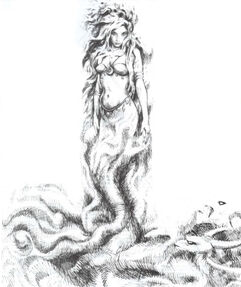
Female Genie
Araby was always a very polytheistic land. The gods of Nehekhara were always worshiped in their eastern cities,[20a] and the gods of the Old World have temples and chapels in the coastal cities. Although without a doubt, the Arabyan people especially adore the Djinns. These elemental beings, wild and angry by nature, are the target of offerings and prayers by the common people, who deeply fear their anger, and try to calm the spirits of the desert with gifts of all kinds.[11a] The Cult of the Djinns is led by the Caliphs, Arabyan leaders who rule the cities and their mission is to worship the spirits and keep the balance, to avoid arousing their anger.[28][43a] Over all the Caliphs, the High Priest of Araby, leader of the Cult of the Djinns, rules, as well as the influential Wizard Caliph, another figure of great power in the cult.[21a][28] In the temples of the cities you can see many idols of the Djinns, as well as in the palaces of the nobles.[1a] They are beings of certainly strange character, and their presence usually brings destruction, but there are many who yearn for their power, and try to subdue them, concurring many times in their anger. The most powerful of all are the Genies, who have demonic power and nature, and whose wisdom transcends that of any mortal being.[11a]
Although many Arabyans are not people of gods, and their leaders are not overly concerned with divine mandates,[19a] religion remains present in the life of the Arabyan people. Beyond offerings and prayers, in their own culture they hide a multitude of popular sayings that refer to the Djinns, the most popular gods of Araby. A common phrase to curse in Arabic would be: "May their souls be flayed by Djinn." And a popular phrase of surprise or consternation would be: "Spirits of the sky, water and earth". Arabyans deeply fear arousing the wrath of their powerful gods. That is why they detest those who alter the natural order, and disturb and destroy in their wake, shaking the balance of their homeland.[28] Of all the Djinns that exist, some of the most revered are the Royal Djinns. The most famous them are The Sultan of Flames, seen as a dangerous god of war, the Sea-Monarch, protector goddess of the seas, or the Raging Tempest, wrathful spirit of storms that hunt down the enemies of Araby.[48]
In Araby they usually pray to the spirits with some regularity, especially at sunset. In the temples of the cities of Araby bells ring with some regularity, when people go to the temples to make offerings to the Djinns. Some Old World gods are forbidden in Araby. Sigmar is a very rejected god among the Arabyans, and Handrich is associated with usurers and the his worship is forbidden for any Arabyan. Similarly, evil gods related to darkness and chaos are prohibited. Be it the chaotic gods or the god Khaine of the elves.[12e][27][43a][73b]
The Arabyans are meticulous about their burials, and we see their great mausoleums described in the tomb of Muammar the Mad, High Priest of Araby. They result in a series of chambers, with different statues, treasures, and canvas inside. The most prestigious Arabyans are buried covered in jewels, attracting crowds of grave robbers.The Arabyans themselves are mummified, a tradition inherited from the lost Nehekhara. Inside the mausoleums there are chapels for prayers, a dressing room with ritual paintings and trunks with the ancient belongings of the deceased.[17d][38a]
Nomadic Tribes
The people of Araby would be divided between those who live in the cities, considered more civilised, and the fierce nomads who roam the dunes, ruled by the Sheikhs of the Desert. The nomadic inhabitants of the desert dwelt in Araby from its foundation, but after the War of the Death, their number skyrocketed.[50a] The destruction of Bel-Aliad, and many other cities of the Great Desert, such as Dakisir[3a], forced its inhabitants to become nomads, roaming the dunes in search of resources. The stories of this time have been kept in the collective memory of the tribes, through stories and songs, recalling the torment that the Undead brought to their land. Some tribes tend to occupy a specific territory, while others travel to distant lands, reaching the Border Princes or the Empire itself.[11a][32c]
Within each tribe the hierarchy is clear. The Sheikh, the undisputed leader of the tribe, is the sovereign. He can be given many names, but this figure always exists as the supreme authority.[32c][49a] The second power is held by the Ani Mukta, the oldest woman in the tribe, who represents wisdom. She has many brave warriors as her personal guard. The ambitious and young warriors hold the next ranks of power, being the ones in charge of keeping the tribe safe. Many tribes consider the horse a sacred animal, and resolve disputes and conflicts with races through the desert.[49a]
In ancient times, there was an Alcazzar, a Sheikh of Sheikhs, who united all the tribes under his banner. The strength of him were fearsome, true legends in the songs of the nomads. The last of them was Shahid the Red Fox, but after perishing fighting Nagash alongside the Seven Kings, no one has managed to claim the title again.[49a] Today, a multitude of tribes have been established, each with its own idiosyncrasy, culture and religion, among which we can highlight:
- Al'Rahem - Famous tribe that its excellent mercenaries.[32c]
- Asad - Nomads who roam the coasts east of Al-Haikk, north of the famous Oasis of the Thousand and One Camels.[13]
- Athiopos - The most widespread tribe south of Ka-Sabar.[13]
- Bakr - Tribe that inhabits the territory between Copher and Al-Haikk.[13]
- Bani-al-Akhtar - The most powerful tribe of Araby according to the legends, whose Sheikhs were the terror of any sovereign, and its warriors the toughest of the desert. To this day their number is extremely low.[49a]
- Bedouins - An elusive Arabyan tribe living in retreat in the desert, and trying to avoid all contact.[32c]
- Dhi’B - Tribe that populates the south of the Lands of the Assassins.[13]
- Ghutani - Tribe that occupies the areas bordering the Land of the Death.[13]
- Kaheid - The nomadic clan that extends north of El-Kalabad.[13]
- Malaluk - Occupying the territory near the west of Zandri, they are famous for their Desert Riders.[13]
- Muktarhin - Legendary tribe of unbeatable warriors in the dunes. Some members of this tribe are part of the mercenary company known as the Desert Dogs.[3a]
- Muzil - Clan of the desert near the ruins of Bel-Aliad.[13]
- Nasr - Tribe that dwells in the desert near the Eye of the Panther.[13]
- Nazir - Nicknamed the Lions of the Desert, they are a proud clan of bandits and warriors.
- Qu'rashi - A tribe that claims that Nagash lived among them and sired a child.[72a]
- Scythans - A tribe of nomads that came to the city of Numas at a certain time, and these, believing that Prince Tutankhanut was an incarnation of their god, worshiped him, occupying and rehabilitating the city. They inhabit in harmony with the dead, recovering the former glory of Numas.[20b]
- Tuareg - They inhabit the east of the Atalan mountains, being fierce warriors and bandits feared throughout Araby.[13]
- Tayif - The southernmost nomads of Araby, inhabiting the border with the jungles of the Southlands.[13]
- Turjuk - Tribe that haunts the areas adjacent to the Land of the Death, they are legendary horsemen.[13]
- Zamesi - Tribe whose dominions are to the east of Sudenburg.[13]
History and Chronology (Imperial Calendar)
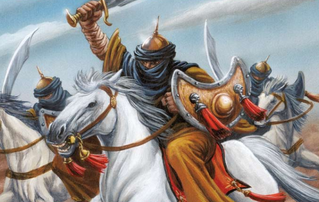
Arabyans sacking the lands of Estalia.
The early years of Arabyan history are not well documented by Old World scholars. We see mentions of a glorious ancient civilization, as well as the fierce inhabitants of the desert. In the ancient days, Araby rose as one of the most powerful human nations in the world. They established colonies in the Old World, and their goal there was to enslave the primitive tribes of men who inhabited the forests of the Old World. Thus they came into contact with the Norsemen, whose common interest in slavery favored trade between the two peoples. Many lands were occupied by the Arabyans during their golden age, such as the southern Old World and the Border Princes, which is why the Arabyan rulers claim these lands as their own.[11a][27]
The High Elves, for their part, established colonies on this land during its maritime expansion. This contact with the Asur favored the Arabyans in their technological and cultural expansion, in addition to learning from them many of the secrets of magic. Arabyan architecture is highly influenced by elvish art, as this people grew up with the Asur, and their friendship has remained in force throughout the centuries. But they have not been exempt from confrontations, since the vanity of the Elves and the pride of the Arabyans has led them to take up arms on more than one occasion.[11a][56a]
Nomadic Arabyans came into contact with the Priest-Kings at the dawn of civilization, raiding their lands during the reign of Rakaph III of Nehekhara. This faced the tribes of the desert, and his mandate was marked by a series of looting and skirmishes in the various attempts of the nomads to raze the cities of Nehekhara. In addition, the tribes had a large presence in the west, and some even occupied cities, as is the case with Bhagar.[20c] The relationship between the throne of Bel-Aliad and the sovereigns of Khemri was one of vassalage, and there was an alliance between the two empires. From the time of Settra, who was known as the “Tyrant of Araby” and “Arch-Sultan of the Atalan Mountains”, the Arabyans of Bel-Aliad were counted as vassals of the Priest-Kings.[16b][61] The Arabyans assisted their Nehekhara neighbors during the war against the undead hordes. The city-states of Bel Aliad, Bhagar and Ka-Sabar were conquered during the reign of Alcadizaar and their Djinns Summoners participated in the destruction of Lahmia.[24a] As a result, Araby was invaded by Arkhan the Black and the vengeful Tomb Kings of the Land of the Dead after the fall of the Khemri civilization by the Great Necromancer Nagash.[50a][60a]
In the ancient days, Araby was a divided nation, even more so than today. Each city had its own sovereign ruler, and no figure united them in case of conflict. That was an era of chaos and civil war between the different Arabyan states, until around the year -2000 IC, Mullah Aklan'd managed to unify all of Araby under the throne of the Great Sultan. And to the present day his lineage has been maintained, although not without interruptions, as happened during the Crusades. That is why the Arabyans still venerate his figure with devotion today, as the greatest legend that has been born among the Arabyan people.[56a][62]
- C. -2000 -- Mullah Aklan'd, a young and celebrated Arabyan warrior native to the island of Fyrus, begins to assemble a large army to drive the High Elves out of Araby. His hatred of the elves stemmed from a series of looting and assaults perpetrated by Asur. Mullah manages to reconquer Fyrus from the hands of the elves, to unite Araby under his command, thus becoming the first Great Sultan of Araby.[56a][62]
- -1750 -- The hosts of Araby march to war together with the Army of the Seven Kings, with the aim of ending the reign of terror in Nagash. This act will condemn them to the wrath and vengeance of the Undead for the rest of their history.[16a]
- -1744 --The Battle of Bronze occurs, where the army of the Great Sultan Suhedir al-Khazem faces an alliance between Ka-Sabar and Bhagar, led by Akhmen-hotep, sent to end his claims of sovereignty. After days of fighting, victory went to the champion of Nehekhara, who forced his enemy to pledge allegiance to Khemri again.[63a][63b][63c]
- -1420 -- The Skaven venture into Araby for the first time, beginning to establish their underground strongholds. This great Skaven invasion of Araby will be remembered as the Plague of the Scholars, and was regarded by the Arabyan people as a divine punishment.[9b]
- -1170 -- The armies of Araby depart from Bel-Aliad to support Nehekhara in the looting and destruction of Lahmia. The Wizards of Araby use the power of the Djinns to confront the vampires of the cursed city. Many vampires will remember this act, and will seek revenge against Araby for the rest of eternity.[24a]
- -1150 -- Terrible sandstorms and plagues hit the cities of Araby. Bel-Aliad is the most affected city, where a good part of the town perished due to the terrible drought and subsequent famine.[20a]
- -1149 -- Arkhan the Black invaded Araby with his Undead army and sacked the city of Bel-Aliad, starting what would become known as the War of Death, a thousand-year conflict in which Arkhan reduced the once powerful and rich Arabyan civilization to a few weak city-states and a handful of fiercely independent desert tribes.[20b][50a]
- -1147 -- The Battle of the Widow happens, in the heart of Lashiek. As Arkhan the Black ravaged eastern Araby, Neferata allied with the ruler of Lashiek, the Dowager Concubine, to kill W’soran, who was hiding in an abandoned house within the city. Two great hordes of Undead collided in the center of the city, while Neferata sought to kill his old enemy.[64a]
- -150 -- The Wars of Death end, as Nagash calls Arkhan back to the Land of the Dead. Araby is broken and weakened after a millennium of war.[50a]
- 271 -- Given the actions of the Lizardmen, great continental alignments occur. A series of earthquakes ravage the lands of Araby.[70a]
- C. 500 -- Arabyan Prince Abdul ben Raschid departs from Ka-Sabar to enter desolate Nehekhara. His eight-year journey eventually drove him mad, writing his celebrated Book of Death in the process, and dying in strange circumstances shortly after.[35a]
- 1150 -- Ibn Jellaba, a famous Arabyan explorer, discovered the lost city of the Lizardmen of Zlatlan. There he was well received, as the Slanns predicted his arrival, and he was able to trade peacefully. They exchanged the pearls and spices of Araby for the abundant gold of the Lizardmen, since the gold had no meaning to them. In previous years a commercial war had started between Araby, Cathay and the High Elves. Thanks to this wealth the arabyans could create a fleet to face the enemies of Araby in the South Seas. Jellaba returned to Ka-Sabar a very wealthy man after establishing the first trade agreement between the Lizardmen and humans.[14a]
- 1230 -- The insane Arabyan sorcerer Mahik al'Rak creates the Portal of Twilight in the ruins of Bel-Aliad, enchanting a series of mirrors. Shortly after, his body was possessed by the Lord of Change, who would influence the magical practices of Araby in favor of the glory of Tzeentch. As a result, this land will never be completely free of its corruption.[39a]
- 1240 -- The corsairs of Araby, led by Nafel Muq, take the island of Sartosa, and establish their base there, from which they will launch all kinds of attacks on the shores of Tilea. Around Sartosa, numerous naval battles were fought between the Corsairs and the galleys of Luccini, Remas and Tobaro. This is the beginning of the so-called Arabyan Wars, a series of conflicts that will confront the corsairs of Araby with the different nations of the south of the Old World, reaching their climax in the Crusades. By this time, the splendor of yesteryear had returned to the cities of Araby, fully recovered from the ravages of the War of Death.[3b]
- 1435 -- Jaffar, a powerful Arabyan sorcerer, forged a coalition with various desert tribes and expanded his power to create a small empire by capturing Al-Haikk, Copher, Martek, and Lashiek, proclaiming himself Great Sultan. Legends say that he invoked demons and conversed with spirits. The Skaven of Araby secretly allied with him, spying on and assassinating his rivals in exchange for Warpstone.[1a][2a][3e][8a]
- 1437 -- An expedition of Arabyan reavers arrives in Nehekhara in search of scrolls and sacred texts. They ransack the necropolis of Zandri and slay many Liche Priests who were guarding the scrolls. They then come onto Khemri and break into the tombs of kings, causing them to awaken in wrath. Great slaughter is made among them.[68a]
- 1448 -- Convinced by the wicked Skaven that the Estalians planned to invade his domain and overthrow him, Jaffar assembled a vast army and prepared his fleet for war. He quickly took the city of Magritta, and marched against nearby Tobaro, while invading all of Estalian territory. In response, large contingents of knights from Bretonnia and the Empire drove the Arabyan forces back to their land after the Battle of Magritta. Out of these conflicts arose many Orders of Chivalry of the Empire and Bretonnia, including the Knights of the Blazing Sun or the Knights of Magritta. Therefore the Crusades against Araby begin.[1a][3e][5c][8a]
- 1450 -- Crusader forces arrive in Araby to end the threat of Jaffar. They quickly take Copher into a bloody massacre, where soldiers and innocents alike were killed. Soon after, the crusaders suffered a crushing defeat at the hands of Mehmed-bey in the Battle of the Nine Jackals. But little by little, the crusaders were approaching the Arabyan capital.[1a][2a][25]
- 1451 -- The Battle of Al-Haikk takes place, in which Jaffar and his forces are defeated, and Jaffar himself is killed by an unknown Bretonnian. His defeat was preceded by the abandonment of the nomadic tribes, and the betrayal of the inhabitants of Al-Haikk, who, repudiating the sorcerer, allied with the crusaders to end the tyrannical Jaffar. They forced him to face the invaders in the open, condemning him to defeat. Mehmed-bey set out to the aid of his lord, but was intercepted and defeated by the Duke of Aquitaine at the Battle of the Black Lizard.[1a][2a][25]
- 1452 -- The crusaders, united with the inhabitants of Araby themselves, liberate the cities in the hands of those loyal to Jaffar, such as Martek and Lashiek. Finally, the invaders decide to settle in the Gulf of Medes, founding the cities of Sudenburg and Antoch. The Jaffar forces they did succeed were seldom hunted and wiped out in a ravine in the Atalan Mountains by the Panther Knights, causing that area to become known as the Eye of the Panther.[5c][51a]
- 1456 -- The Emir Wazar the Cruel is defeated in the siege of Magritta, ending the Arabyan presence on the Estalian peninsula. The emir himself is crushed to death alongside his Black Scimitar Guard under the weight of a statue of Myrmidia, at the moment when Wazar appeared to be tracing the battle.[51a]
- 1475 -- A combined force of crusaders from the Empire and Bretonnia loot the ruins of the Arabyan city of Bel-Aliad. Inadvertently they activate the Portal of Twilight, disappearing into the Realm of Chaos, where they become part of Khorne's eternal war.[74]
- 1500 -- Great Sultan Daryus-e Qabir launches a series of religious wars against the Old World. His intention was to maintain his positions beyond the sea, as well as avenge the Crusades and quell the wrath of the spirits, though he did not achieve any lasting success. After several defeats, the Arabyan Wars ended, and although the legends of this era have strained Old World attitudes towards the inhabitants of Araby, constant trade has restored a certain stability in diplomatic relations.[3b][4c]
- 1501 -- The island of Sartosa is taken from Emir Abd al Wazaq and his corsairs, at the hands of a mercenary army led by Luciano Catena of Luccini. After a long and bloody siege, Luciano included Al Wazaq returning to Araby, but leaving his treasure behind him. He also left his harem, which had been trained to serve as his personal guard, and the women ended up serving as mercenaries in the ranks of the Tilean armies. The same happened with the surviving Arabyan corsairs, this being one of the first times Arabyans were hired as mercenaries in Tilea.[3b]
- 1550 -- The last imperial knights withdraw from Araby, ceasing their quest for revenge, thus ending with the last loyal to Jaffar and definitively concluding the Crusades.[2a]
- 1600 -- Abdul Al'Shar invades the Masserschloss region of the Border Princes. He fought the Greenskins, and eventually settled in the area. He began to exploit an iron mine in the vicinity. He was murdered a few months later by one of his servants.[46b]
- 1726 -- King Rakaph of Khemri invades Araby with his armies. Three great battles are fought in the sands between the hosts of the Arabyans and the Tomb King. Although Rakaph does not achieve any meaningful or lasting conquest, he does get the rulers of Araby to pay him war tributes.[68a]
- 1800 -- The iron mines were exhausted, and Abdul Al'Shar's principalities were reduced to a series of lesser men until his little kingdoms collapsed under the weight of his own corruption.[46b]
- 1900 -- Arabyan cities begin to trade with the distant port of Erengrad, increasingly influential thanks to the Gospodar government.[69a]
- 2103 -- The Bloodhunt tribe invades the shores of Araby in order to honor Khorne. The emirs were forced to send their vast armies against them. Though the invaders were eventually defeated, they left such a trail of blood behind them that Khorne gratefully led the Crimson River across Araby as a testament to his sacrifice.[42a]
- 2295 -- Scyla Anfinngrim, renowned warrior of Khorne, decides to attack the coasts of Araby, facing the fleet of war dhows of the powerful Arabyan admiral Ibn Dhul. The Servant of Chaos reduced his fleet to a pile of splinters.[65]
- 2475 -- The New World colonies create a vast network of commerce, and those treasures they found in the jungles are sold in the ports of Nippon, Cathay, Marienburg and Araby.[12a]
- 2498 -- The Siege of Sudenburg occurs, in which a horde of Undead from Khemri try to destroy the imperial colony. The Imperials and Arabyans manage to expel them back to the desert, with the help of Bretonnians and mercenaries. Thus began the Wars against Khemri.[66a]
- 2500 -- The city of Antoch is destroyed at the hands of the Lizardmen, given the theft of a certain sacred artifact centuries ago. The settlement is razed, weakening the alliance that protected the area from the Tomb Kings.[22a]
- 2502 -- The Sultan of Copher begins to spy on the Knights of Magritta, following the destruction of several ships in his fleet. The leader of his spies is Shihab Ibn Alim, an Arabyan sorcerer. Using his Djinns and information obtained by Shihab Ibn Alim, the Sultan of Copher conspires against the Knights of Magritta.[6b]
- C. 2510 -- The Prophet of Law begins to preach in Araby. Like in the era of Mullah Aklan'd, he asserts that non-human races are the evil of his land, and that they must be destroyed, as did the first Great Sultan. From this year on, he will not stop gaining followers, and his speech will permeate the Arabyan people and his leaders.[26a][53]
- 2521 -- Princess Yuleh it Toorissi gives a coup in the city of Ras Karim, together with her lover Halim it Saredi, leader of the rebels. She thus ending the tyrannical rule of her cousin, Falhedar it Toorissi, and proclaiming herself the ruling Princess. Highlight the invaluable help of the adventurers Gotrek and Felix, who contributed to the victory of the rebel cause. That same year, the Al Muktar's Desert Dogs were founded as we know them today. They were sent to the Deathlands by contract of the Sultan of Lashiek, as well as subsequently being hired to serve in the Border Princes.[3a][28]
- 2522 -- Conflicts with the Tomb Kings reach their peak. Commanded by the Great Sultan Padishah the Great, the Arabyans and their Asur allies wage bloody battles in the Wars against Khemri, such as the Siege of Copher and the Battle for Araby. General Aethos of the High Elves decide to enter the heart of Khemri in search of an ancient artifact, with catastrophic consequences.[67]
Cities
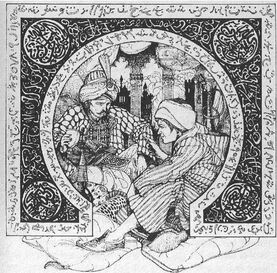
Orfeo and Alkadi Nasreen talk in Arjijil
All the Arabyan city-states sit on the western coast of the continent, as the center is dominated by the Great Desert of Araby, infested with nomads.[11a] Beyond the Great Desert lies the city of Bel-Aliad, the closest human settlement to the Land of the Dead, now ravaged. Few cities in Araby remain beyond the Atalan Mountains, but some of them are close to the Southlands.[17b] In fact, since Ibn Jellaba's great journey, many Arabyan colonies have risen up on the coast of the Southlands as trading enclaves to exchange goods with native humans, as well as with the Lizardmen.[14a][18a]
In the seven great cities of Araby there is a Sultan, all loyal to the Golden Thrones of the Great Sultan. The smaller cities are ruled by the Princes, and those even smaller, by Emirs. Small villages are scattered along the coast, as well as nomadic camps, but these villages are usually under the protection of an Emir or Prince. All of them are vassals of the nearest Sultan.[11a][43a]
- Aiir - Located in the southwest of Araby, this city is a large city, surrounded by two minor cities, Sadiz and Kust. Their current sultan is Hamqa, a wealthy merchant, known as "the Divine."[54]
- Al-Haikk - Known as the City of Thieves, it is the largest commercial port in Araby. Home of the Great Sultan, hub of commerce and capital of Araby.[11a][13]
- Amhabal - Arabyan city based on handicrafts and silk production. Its markets are heavily traveled by wealthy leaders from distant nations.[55]
- Arjijil - Port city of Araby, impregnable according to many, famous for its markets and for being a haven for pirates. It is located on the Pirate Coast of Araby, east of Al-Haikk.[43a]
- Barrakeesh - Located north of Lashiek, this city is protected by a large cabal of wizards and a significant watch of magic carpet riders.[57a]
- Bur-Shitrak - Arabyan city, with a large presence of nomadic tribes, famous for the exotic beasts that can be found in its surroundings. From parrots and snakes to a strange breed of desert jackals called Mukkavi.[12d]
- Copher - The most independent Arabyan city, famed for its spice trade and home to scholars and wizards as well as the feared pirates of Copher.[13]
- Djambiya - Port city located on the borders with the Land of the Death. Its people are tremendously superstitious, and fear to enter the deserts of the east, since hundreds of myths and legends of the natives warn of the presence of an ancient and terrible evil.[31b]
- El-Kalabad - City that is in the Gulf of Medes, south of Araby. Fabulously rich thanks to trade with the nations of the Far East. The Sultan of Medes controls an immense army, always ready to kill enemies from the southern seas, or the eastern deserts.[13]
- El-Khabbath - Nicknamed the City of the Eight Winds, it is a very important port city in Araby, as it is used by both merchants and privateers to exchange their products. A meeting point for all the sailors of the world, the city is being famous for the devotion of its inhabitants to the spirits of the desert..[33a]
- Fyrus - Island near the coast of Al-Haikk, whose city was occupied during the crusades by the Knights of Origo, to be later recovered by the throne of Araby. It is a highly revered place, as Mullah Aklan'd, the first Great Sultan of Araby, was born there.[56a]
- Gobi-Alain - Merchant city famous for the immense stained glass window, rich in colors and details, that decorates the palace of the emir who governs it. The surrounding lands are full of merchant caravans, as many trade routes coincide in Gobi-Alain.[19a]
- Sorcerer’s Islands - These islands lie off the coast of Lashiek, and are home to the Arabyan College of Sorcerers.[11a][13]
- Qadira - Arabyan city, also called Quadir, famous for its crowded bazaars, skillful but dangerous dancers and hidden treasures. This city, located at the southern end of the Gulf of Medes, is known for its huge ports, and for being besieged by a constant and suffocating heat. In addition, it is rumored that a terrible curse hangs on the Princess who rules the city.[53]
- Kamt - Situated on the eastern limits of Araby, this city is famous for its rulers' interest in the arts. Its courts are full of skilled musicians, sculptors, poets, and actors. It is a center of culture, attracting many artists from the Old World.[43a]
- Ka-Sabar - It is the southernmost city in Araby, located on the edge of the jungles of the Southlands. Ancient city of Nehekhara destroyed by Nagash, it was later inhabited and rebuilt by the Arabyans.[13]
- Kust - Located in the southwest of Araby, it surrounds the great Aiir. Great renowned military men have been raised in the training grounds of this city. Its leader is called Regal.[54]
- Lashiek - Known as the City of Corsairs, the mighty Arabyan fleet is located there. It is also feared as the world center of the slave trade.[13]
- Martek - A city rich from mining the Atalan Mountains and surrounding the bottomless lake of Fazoth-Ar, in which are said to dwell sinister forces.[13]
- Meknes - An important port located in southern Araby, rising up with a great military force thanks to its fleets. Its shipyards are really busy, and it is a last refuge for those who travel to Cathay.[54]
- Palace of the Wizard Caliph - Inside Araby, in the southern tip of the Arabyan Mountains.[13]
- Ras Karim - City located between Al-Haikk and Copher, famous for its large docks and its commercial influx. It is currently ruled by Princess Yuleh it Toorissi, after the tyrannical and cruel government of her cousin was overthrown.[28]
- Sadiz - City in southwestern Araby, surrounding the great city of Aiir. Its leader receives the title of Suzerain.[54]
- Sanaá - Arabyan city in which the sorcerer Abdul Alhazred was born.[58a]
- Songhai - Situated in southern Araby, this city is ruled by an influential prince, with power that rivals the sultans. It is thanks to his countless riches that the Songhai throne has managed to rise to such a position.[43a]
- Sud - City located in western Araby, south of Lashiek and the Palace of the Wizard Caliph. It is one of the cities with the greatest presence of people from the north, and its merchants come to venture to distant lands, such as Albion, in search of strange products.[43a]
- Sudrat - Arabyan city famous for its trade with the East, and with a stable contact with these nations.[55]
- Teshert - Fortified city, located beyond Araby, at the southern tip of the Badlands. The powerful host that garrisons Teshert secures the only route linking Araby with Barak Varr and the Border Princes, being a safe passage for the caravans. The city's emir rules over the adjoining desert, called Marg Beh-Mard, plagued with monsters and dangers.[43a]
Colonies in Araby
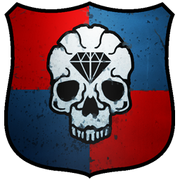
Heraldry of Sudenburg
- Antoch - Formerly known as the Crusader City, it was founded by Bretonnian knights after the Crusades against Araby on the northern coast of the Gulf of Medes. It was destroyed ca. 2500 IC by the Lizardmen, who sought to recover an artifact stolen some 700 years before by Pierre d'Antoch.[22a]
- Akhaba - Akhaba is a remote settlement within the Gulf of Medes, its desert fortress once occupied by the High Elves. It could be after the flight of the elves, probably as a result of the war with Mullah Aklan'd, it would be occupied by the Arabyans. Its ruling prince is traditionally nicknamed "Lord of the Anvil of the Sun".[56a][59a]
- Elven Ruins of Araby - The remains of a once great coastal city are found on the southern tip of Araby, testifying that the entire coast of Araby was once a colony of the High Elves. It was abandoned around -1500 CI, following the war with Mullah Aklan'd.[13][56a]
- Sudenburg - Not an Arabyan city, but an Imperial colony that was founded during the time of the Crusades against Araby. Because it is inside the Gulf of Medes, it makes it a very important enclave for businesses dealing with the Old World.[1a][2a][13]
Uninhabited
- Bel-Aliad - It is an ancient Arabyan city near Nehekhara. It is currently in ruins and engulfed by the desert sand. It was once the capital of Araby, when it was a proud and united civilization, until it was destroyed by the Undead raised by Arkhan the Black in -1149 CI. Precious treasures are said to be hidden in these ruins, but few adventurers return to confirm the stories.[13][60a]
- Dakisir - Ancient Arabyan city, now reduced to a handful of ruins engulfed by sand. It was famous for its forges, where magical weapons of legendary quality were made. It was destroyed by the Undead of Arkhan the Black during the War of Death.[3a]
Flora and Fauna
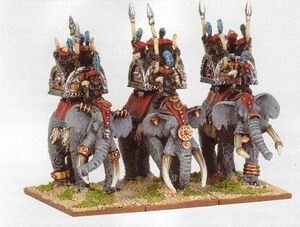
In Araby we can find an exotic and varied fauna, lost in the immensity of the dunes. Lions, Giant Wolves and panthers are common creatures in the Southlands, as well as in many regions of Araby.[51a][52a] Camels are essential for life in the desert, being used by both merchants and warriors.[11a] Jackals roam the deserts, being frequent in mountainous areas. They are a very common pet in Araby, also used for dog racing.[12c][31a] We know of the existence of the Radiant Pegasus, inhabitants of the sunny plateaus of Araby. They are dangerous creatures, with the power to burn their enemy with a powerful blaze.[34b] Creatures from the southern jungles roam the dunes, such as elephants or great apes. Immense Giant Serpent also inhabit these territories, and many of these beings end up in the private zoos of the sultans, who love to collect strange creatures.[28] Giant Vultures also live in the mountains of Araby, large enough to carry a horse between their claws, which the Arabyans are capable of using for war.[1a]
The Arabyan seas are extremely rich in fauna, which is why fishing is an essential food source for the Arabyans.[11a] Although we not only found small schools of fish. The dolphins hover between the boats, jumping around the bow. Along with them, dangerous sharks are waiting on the prowl, ready to pounce on the most unwary sailor. Their number is such that they give their name to the strait that separates the Land of the Assassins from the Sorcerers Islands, known as the Strait of Sharks. Although in the Arabyan seas, the most dangerous being is the Leviathan, whose jaws can devour the strongest ship with little effort.[13][53]
The Arabyans are in the habit of using poisons in their weapons, extracted from creatures of the desert.[41a] They would highlight, for example, the Green Scorpion Venom, or the Viper's Kiss, which is obtained from the deadly black speckled vipers.[30g] Another animal from which poison is extracted is the Tomb Scarab. With a drop of his poison, spilled on an Undead bone placed on a rope, he will form a pendulum. This pendulum will swing in the direction of the nearest vampire, being used by the warriors of Araby to locate vampires in their lands. Although those who use the pendulum must be careful, because the poison of the Tomb Scarab never loses its effectiveness, and can be a deadly weapon.[36b] Another famous poison is the one that is extracted from the Black Lotus, which grows in a plains in southern Araby known as the Black Plains.[12d]
Other great creatures roam the lands of Araby. Some isolated Giants bands live amongst the Worlds Edge Mountains, even so far south as Araby. The Dragons were masters of forests and mountaintops. Today they are a legend, and few Dragons exist live in almost perpetual slumber within deep caverns amongst their ancestral nesting site, the Worlds Edge Mountains and Mountains of Mourn.Dragons probably exist now only in handfuls scattered throughout the world. Probably there are several dozen scattered throughout the Old World, and as many again in Araby and western Cathay. Mummies are often found in Araby's tombs, and someonas Arabyans treat the dead in such a way as a custom inherited from the lost Nehekhara. And some rarely come back to life, being relatively rare and solitary creatures.[17c][17d][17e][17f]
Military
"Much of the Butcher's army is Mameluk slave-soldiers, but armoured Janissaries and sun-blackened Dervishers march under the Black Lizard as well. Nomad riders guard the flanks and Sipahis on strong desert horses make up the vanguard."
- —The Duke of Aquitaine, observing the Arabyan army of Mehmed-bey, the Black Lizard.[25]
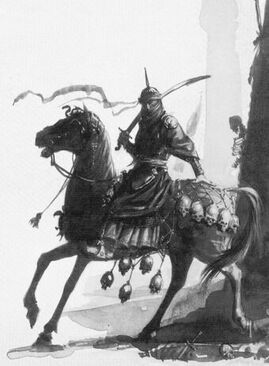
An Arabyan warrior scouting the dreaded Land of the Dead.
The sultans are proud of their troops and especially of their cavalry so that no expense is spared either on their equipment or maintenance. It is popularly supposed that the horses of Araby are descended from Elven horses brought over from the west many centuries ago. They are graceful and swift creatures and very highly valued. The very best of the Arabyan foot-soldiers are also well equipped, with steel armour, keen tulwars, gleaming helmets, and fine silk clothing. These household troops or guards accompany the sultans when they travel beyond the grounds of their magnificent palaces.[11a]
The loyalty of these troops is famous. They are amply rewarded with riches, luxuries, and prestige as a result. The ordinary foot soldiers are more plainly equipped and usually carry simple iron-hafted spears or bows. As well as these regular and garrison troops there are the irregular fighters from the desert tribes, including camel mounted warriors from the lands to the south and east.[11a]
Arabyans are organised into quite formal Regiments, with a good permanent military structure. Arabyans have so many different kinds of troops available that their tactics may be varied from one battle to another. Great use can be made of the unarmoured horsemen, who are able to skirmish against enemy formations whilst waiting to penetrate their lines and attack from the rear. Camels and Elephants have their place too. Elephants make excellent battering rams which can be charged against solid blocks of enemy troops. Elephants can be supponted by the Arabyans infantry, whilst the Dervishers rush ahead to tie up the advance enemy units.[71a]
In Araby, heavy armour is impractical given the unforgiving climate. Instead, to shield themselves from the oppressive heat of the sun, they wear voluminous robes and body coverings that also making them harder to hit.[30b] Arabyans warriors wear white or off-white clothing, with turbans often of a uniform colour within a Regiment. Some units may wear coloured their clothes with bright colors, over the tunics and trousers. Armour is often worn underneath the tunic, but where visible is steel, and ocasionally with bronze, copper or gold decoration. Regimental officers and some other personalities can wear black clothing, as do some of the desert tribemen. Weapons are of steel. Shields are generally of one solid colour, sometimes with decorative tassles made out of horse hair and dyed red. Spear shafts and bows are natural wood colour. Banners will be any solid eolour and usually carry either a single device in a contrasting colour, or else reams and reams of text from the Great Sacred Books of the great arabyan sage Mullah Aklan'd.[71a]
Araby merchants introduced the scimitar to the Old World. Though a sword, its curved blade, single edge, and lightweight lend it speed and accuracy in the hands of a skilled fighter. The severity of the curve varies considerably, though they are all equally effective. Scimitars, like swords, come in one- and two-handed varieties, with blades as long as 3 feet. It’s believed that scimitars evolved from the khopesh. One-handed scimitars have the same statistics as rapiers. Two-handed scimitars are big weapons; the blade widens as it reaches the tip. It has the same statistics as a great weapon.[30c]
Firearms are common in Araby, both handguns and the famous jezzail rifles, from which the large rifles of the oldworlders and skavens would develop.[30e] Especially these weapons are found among corsairs and nomads. Among the most exotic weapons that we can find in Araby are; the Katar, a broad-bladed dagger, held by a glove to the hand. The Jambiya, a highly ornate curved dagger. And the Tufenk, light muskets used by some nomadic tribes.[32b]
The wizards of Araby are a force to be reckoned with on the battlefield. Their control over the elemental spirits allow them to unleash terror among the enemy ranks. They rule over multitudes of elemental creatures, each with unique abilities, who are subject to their will. In addition, the own magic of Araby grants them power to finish with any invader of the desert. Beasts of war are common in the armies of Araby, devastating enemies with their fierce charges.[11a]
Arabyan Infantry
- Arabyan Spearmen - Arabyan armies are based upon regiments of infantry. They garrison the cities and towns and enforce law and order throughout Araby as well as forming its standing army. The majority of these warriors carry tall spears and shields and fight in well-disciplined ranks.[11a]
- Arabyan Guards - The household troops of the rulers of Araby, known in their own tongue as Janissaries, are famously loyal and lavishly equipped - they carry weapons of the finest quality and wear brightly coloured clothes of silk brocade.[11a]
- Arabyan Bowmen - The men of Araby place great faith in the bow and all the cities of Araby maintain strong bodies of archers. Although firearms are known in Araby, they are nowhere near as common or as advanced as those used in the Old World and are rarely issued to common troops.[11a]
- Dervishers - Considered to be the most notable units fielded in Araby, Dervishers are fanatic religious warriors all too willing to die for their god.[11a]
- Mamelukes - A lowly form of slave-soldier, infamously utilised by Mehmed-bey during his battle against the Duke of Aquitaine.[25]
- Eunochs - Eunochs are only rarely slaves, more often they are individuals brought up and trained as warriors or guards. They are unusually steadfast and loyal.[17b]
Arabyan Cavalry
- Arabyan Knights - Arabyan Knights, known in their own tongue as Sipahis, are the cavalry-elite of Araby. They are considered mad with hate, arrogant with pride and the terrors of the desert.[2][11b]
- Arabyan Desert Riders - The deep deserts of Araby are home to fierce, nomadic Desert Riders. Known as Akincis in their own tongue, these warriors are the best light cavalry in all the land.[11b]
- Arabyan Camel Riders - Camel Riders are an exotic form of cavalry utilised by the Arabyan military. It is only the fierce warriors of the desert tribes that ride these intractable creatures into battle. Camel Riders are brave and notoriously savage warriors.[11b]
- Arabyan Flying Carpets - The sorcerers of Araby have perfected the art of binding aerial spirits into physical forms - not least of which is the famous Flying Carpet.[11b]
Arabyan Warbeasts
- Elephants - Elephants are an exotic creature even in Araby for they come from the lush bushlands that lie between Araby and the jungles of the Southlands.[11b]
Arabyan Heroes
- Arabyan Magicians - Arabyan Magicians, known in their own tongue as Fakirs, are the great sorcerers of Araby - mystics of the southern deserts and court magicians of the Sultans themselves.[11b]
- Arabyan Champions - The Champions of Araby are often noble relatives to a Sheikh or other high ranking Commanders.[11b]
Arabyan Lords
- Arabyan Commanders - The commander of an Arabyan army is likely to be a Grand Vizier - perhaps the Grand Vizier of the Great Sultan himself. Subordinate to the overall commander are marshals and commanders of lesser rank within the palace hierarchy, noble Emirs, and Sheiks from the desert.[11b]
Notable Characters
- Padishah
Canon Conflicts
- In Warhammer: Battle Bestiary, it is stated that the god the Arabyans worship is called "Allah," which is the name of God in Islam. Later, in the Orfeo Trilogy, the god of Araby was referred to as The One. Although there are some other references, all of them are from the 80's. In later versions, the Arabyans would be impious, or worshipers of the Djinns. Especially in the more recent versions of its background, as in Two Crowns of Ras Karim, the Cult of the Djinns is much more present, while the lore on the monotheistic religion of Araby was abandoned with time and replaced by this one.
- The Arabyans were represented as technologically backward in the first versions of the lore, which would later be replaced by mentions of great advances in scientists as well as engineering. Advances in lore can be seen especially in the mentions of Araby in Blood of the Reik, as well as in the Warmaster lore. Additionally, the more modern stories of Gotrek and Felix, some of them set in and around Araby, provide new information that contradicts the older lore of this faction.
Trivia
- Araby is based on Medieval European ideas about the Islamic world and Middle Eastern mythology and fiction, as well as Historical aspects from the Ottoman Empire, specifically it's military. The references refer to the entire Islamic world, from the African kingdoms such as Songhai to the different dynasties of the medieval caliphates. Geographically speaking, the area comprising real-world Arabia has been shifted and stuck to the northwest of the macro-area that mimics Africa in the world of Warhammer.
- In earlier editions, natives of Araby were called "Arabs" and "Arabians", this was changed in later editions to "Arabyans", likely for copyright reasons. In Poland, the name "Arabia" is the official translation, but the natives of Araby are called "Arabianie" instead of "Arabowie" (the correct Polish way of writing "Arabs"). In Italian and Spanish versions they refer to the region as Arabia, and in French it is referred to as Arabie.
Miniatures
Sources
- 1: Warhammer Armies: Bretonnia (5th Edition)
- 1a: pg. 13
- 2: Warhammer Armies: Bretonnia (6th Edition)
- 2a: pg. 33
- 3: Warhammer Armies: Dogs of War (5th Edition)
- 4: Warhammer RPG 1st Edition: Core Rulebook
- 5: Warhammer RPG 2nd Edition: Core Rulebook
- 6: Warhammer RPG 2nd Edition: Shades of the Empire
- 7: Warhammer RPG 2nd Edition: Tome of Corruption
- 7a: pg. 140
- 8: Warhammer RPG 2nd Edition: Knights of the Grail
- 8a: pg. 20
- 9: Warhammer RPG 2nd Edition: Children of the Horned Rat
- 10: Warhammer RPG 2nd Edition: Tome of Salvation
- 11: Warmaster: Armies (2006)
- 12: Marienburg: Sold Down the River - WFRP (1st Edition)
- 13: A map of The Land of the Dead and Araby
- 14: Warhammer Armies: Lizardmen (5th Edition)
- 14a: pg. 6
- 15: Warhammer Armies: Lizardmen (6th Edition)
- 15a: pg. 73
- 16: Warhammer Armies: Tomb Kings (8th Edition)
- 17: Rulebook - Battle Bestiary (2nd Edition)
- 18: Warhammer Fantasy: Rulebook (6th Edition)
- 18a: pg. 167
- 19: Blood on the Reik (2005)
- 19a: Races of the Old World
- 20: Warhammer Armies: Tomb Kings (6th Edition)
- 21: Warhammer RPG 2nd Edition: Companion
- 22: White Dwarf 207 (UK Edition)
- 22a: pp. 23-26
- 23: White Dwarf 234 (US Edition)
- 23a: pg. 46
- 24: Liber Necris
- 24a: pg. 44-45
- 25: Warhammer: The Red Duke pgs. 161 - 163
- 26: Gotrek and Felix: Giant Slayer (Novel) by William King
- 27: Daemon Gates Trilogy: Night of the Daemon (Novel) by Aaron S. Rosenberg
- 28: Gotrek and Felix: Two Crowns of Ras Karim (Novel) by Nathan Long
- 29: "Forces of Fantasy": A Warhammer Supplement
- 29a: pg.10
- 30: Warhammer RPG 2nd Edition: Old World Armoury
- 31: Town Cryer, Issue 19
- 32: Town Cryer, Issue 20
- 33: Dreadfleet
- 33a: pg. 38-39
- 34: Warhammer Fantasy: Storm of Magic
- 35: Warhammer Armies: Vampire Counts (5th Edition)
- 35a: pg. 8
- 36: Warhammer RPG 2nd Edition: Night's Dark Masters
- 37: Warhammer Armies: Vampire Counts (8th Edition)
- 37a: pg. 63
- 38: Warhammer Fantasy RPG: Death's Dark Shadow (1st Ed)
- 38a: pg. 75-76
- 39: Warhammer Armies: Daemons of Chaos (8th Edition)
- 39a: pg. 18
- 40: Warhammer Armies: Beastmen (6th Edition)
- 40a: pg. 16
- 41: Warhammer: The Orfeo Trilogy: Storm Warriors (Novel) by Brian Craig
- 41a: Prologue
- 42: Warhammer Armies: Warriors of Chaos (7th Edition)
- 42a: pg. 17
- 43: Warhammer: The Orfeo Trilogy: Zaragoz (Novel) by Brian Craig
- 43a: Prologue
- 44: Warhammer: The Orfeo Trilogy: Plague Daemon (Novel) by Brian Craig
- 44a: Prologue
- 45: Warhammer: Fell Cargo (Novel) by Dan Abnett
- 46: Warhammer RPG 2nd Edition: Renegade Crowns
- 47: Old World Bestiary (Fantasy Roleplay)
- 47a: pg. 9
- 48: Dreadfleet (Novel) by Phil Kelly
- 49: Time of Legend: Nagash Immortal (Novel) by Mike Lee
- 49a: Chapter 12: Children of a Hungry God
- 50: Warhammer Armies: Undead (4th Edition)
- 50a: pg. 93
- 51: Warhammer Armies: The Empire (8th Edition)
- 51a: pgs. 41-43
- 52: White Dwarf 310 (UK Edition)
- 52a: pg. 121
- 53: Gotrek and Felix: Redhand's Daughter (Novel) by William King
- 54: Warhammer: The Voyage South (Novel) by Nicola Griffith
- 55: Warhammer: Von Carstein Trilogy: Inheritance (Novel) by Steven Savile
- 56: Warhammer: Citadel Journal Spring 1985
- 56a: pg. 49
- 57: White Dwarf 68 (UK Edition)
- 57a:pg. 68
- 58: Town Cryer, Issue 21
- 58a: pg. 16
- 59: White Dwarf 277 (UK Edition)
- 59a: pg. 18
- 60: White Dwarf 275 (UK Edition)
- 60a: pg. 19
- 61: Total War Warhammer II
- 62: Citadel Miniatures: Regiments of Renown '85
- 63: Time of Legend: Nagash The Sorcerer (Novel) by Mike Lee
- 64: Time of Legend: Master of Death (Novel) by Josh Reynolds
- 64a: Chapter 12
- 65: Talon of Khorne (Short Story by Frank Cavallo)
- 66: Warhammer Fantasy RPG 4th Edition -- Starter Pack (The Adventure Book)
- 66a: pg. 35
- 67: White Dwarf 244 (AU Edition)
- 68: Warhammer Armies: Tomb Kings (7th Edition)
- 68a: pg. 9
- 69: Warhammer Fantasy RPG: Something Rotten in Kislev (1st Ed)
- 69a: pg. 12
- 70: Warhammer Armies: Lizardmen (7th Edition)
- 70a: pg. 24
- 71: "Forces of Fantasy": A Warhammer Supplement: Fighting Fantasy Battles
- 71a: pg. 18
- 72: Warhammer Fantasy RPG 2nd ED -- The Thousand Thrones
- 72a: pg. 157
- 73: Warhammer: The Blades of Chaos (Novel) by Gavin Thorpe
- 74: Warhammer Armies: Daemons of Chaos (7th Edition)
- 74a: pg. 28




